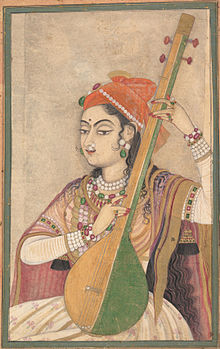
Back তানপুৰা Assamese তানপুরা Bengali/Bangla Tambura Catalan Tampura Czech Tanpura German Tanpura (India) Spanish तानपूरा Hindi Tánpúrá Hungarian Tambura Italian ತಂಬೂರ Kannada
This article has multiple issues. Please help improve it or discuss these issues on the talk page. (Learn how and when to remove these messages)
|






The tanpura (Sanskrit: तंबूरा, romanized: Taṃbūrā; also referred to as tambura, tanpuri, tamboura, or tanpoura) is a long-necked, plucked, four-stringed instrument originating in the Indian subcontinent, found in various forms in Indian music.[1] Visually, the tanpura resembles a simplified sitar or similar lute-like instrument, and is likewise crafted out of a gourd or pumpkin.
The tanpura does not play a melody, but rather creates a meditative ambience, supporting and sustaining the performance of another musician or vocalist, as well as for musicians accompanying a dance performance. The instrument's four strings are tuned to specific notes of a given scale or musical key, normally the fifth (Pa; Solfège, “So”) and the root tonic (Sa; “Do”). The strings are generally tuned 5-8-8-1. One of the three strings tuned to the tonic is thus an octave below the others, adding greater resonance and depth to the ambient drone.
Through continuous, rhythmic plucking of its strings, the tanpura creates a constant harmonic bourdon or drone effect. Uniquely, the tanpura is not played in specific rhythm with the soloist, percussionist, or any other featured musician; the precise timing of plucking a cycle of four strings in a continuous loop is a determinant factor in the resultant sound, and it is played, unchangingly, throughout the whole performance. The tanpurist must keep true to their own rhythm for the duration of the composition, which may be over an hour in some cases, as their drone is critical to the entire musical foundation of the performance. The repeated cycle of plucking the strings in succession creates a sonic canvas on which the melody of the raga (or other composition) is drawn. The sequence of string-plucking is generally (according to pitch) 5-8-8-1, with the fourth and final string plucked being given a slight “rest”, usually two to three seconds, before repeating the cycle. The combined sound of all strings–each string a fundamental tone with its own spectrum of overtones–supports and blends with the external tones sung or played by the soloist.
Northern and central-Indian Hindustani musicians favor the term tanpura (often used within the context of languages such as Bengali, Gujarati, Hindi, Sindhi, Punjabi, etc.), whereas southern and Carnatic musicians normally prefer tambura (for example, in Kannada, Malayalam, Tamil, or Telugu); tanpuri is a smaller variant of the instrument, sometimes used for accompanying instrumental soloists.
- ^ www.wisdomlib.org (12 March 2017). "Tambura: 5 definitions". www.wisdomlib.org. Retrieved 27 October 2022.